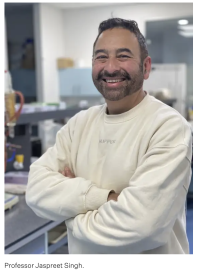|
|||||||||
| DAY 1 - TUESDAY 24th June | |||||||||
| 7.15 - 8.45 |
|
||||||||
| 7.30 | Registration opens | ||||||||
| Session | Welcome & Plenary A - The Roots of Our Heritage | ||||||||
| Venue | Conference Room | ||||||||
| 9.00 - 9.30 | Welcome & Introduction | ||||||||
| 9.30 - 10.00 | Plenary A1: Mavis Mullins (Nga Whenua Rahui) | ||||||||
| 10.00-10.25 | Plenary A2: Richard Archer (Massey University) | ||||||||
| 10.30 - 11.00 | Refreshments | ||||||||
| Session | B1: The Future: Challenges and Opportunities in Food Safety | B2: Supporting the Health of New Zealanders | B3: Converting Waste to Taste | B4: Elements of Innovation | |||||
| Venue | Conference Room | Seminar Room | Meeting Room | The Gallery | |||||
| 11.05-11.32 | B11: Global Megatrends Impacting on Food Safety - Phil Bremer (University of Otago) & Kai as a source of wellness - Fiona Wiremu (NZFSSRC) | B21: Feeding the Future: The Urgent Need for New NZ Nutrition Data and Insights - Cliona Ni Miurchu (University of Auckland) | B31: A step towards a NZ circular bioeconomy: Early food loss and waste in dairy and beef - Jessica O'Connor (University of Otago) | B41: Navigating Analytical Challenges in Novel Foods and Emerging Ingredients - Dr. George Joseph (AsureQuality) | |||||
| 11.32-11.59 | B12: Regulatory - Roger Cook (MPI-NZFS) & Revolutionising Food Safety: Harnessing Technology, Addressing Emerging Risks, and Moving Beyond HACCP - Pierre Venter (Fonterra) | B22: Driving Innovation & Opportunities through the Australian National Nutrition Survey – an Industry Perspective - Jean Kim (Nestlé Australia) | B32: From Waste to Taste: Enhancing Flavour with Mushroom Stalks - Raise Ahmad (Agresearch) | B42: Hybrid Meats: Next generation of plant-based and hybrid (plant-animal) sustainable food analogues - Jaspreet Singh (Massey University) | |||||
| 11.59-12.26 | B13: The Future: Challenges and Opportunities in Food Safety; Panel discussion - Panel Members: Phil Bremer, Fiona Wiremu, Roger Cook, Pierre Venter | B23: Heart Foundation’s Food Reformulation Programme and its impact on the food supply–past, present and future - Deb Sue (Heart Foundation NZ) | B33: Food waste a cost, an opportunity or both? – Hamish Conway (Goodman Fielder) | B43: Driving product success with strategic application of consumer sensory methods - Denise Hunter (Forward Insight and Strategy) | |||||
| 12.30 - 1.30 | Refreshments | ||||||||
| Session | Plenary C : Evolution of Food Systems | ||||||||
| Venue | Conference Room | ||||||||
| 1.30 - 3.00 | Plenary C1: Kevin Marshall (Dairy Industry Expert) | ||||||||
| 2.00 - 2.20 | Plenary C2: Rob Archibald (Meat Industry Expert) | ||||||||
| 2.20 - 2.40 | Plenary C3: Julian Heyes (Horticulture Industry Expert) | ||||||||
| 2.40 - 3.00 | Plenary C4: Volker Kuntzsch (Seafood Industry Expert, Cawthron Institute) | ||||||||
| 3.00 - 3.30 | Refreshments |
|
|||||||
| Session | D1: Food Safety - Emerging Issues | D3: From Cow to Now - Dairy Focus | D4: Exploring the Blue Economy | ||||||
| Venue | Conference Room | Seminar Room | Meeting Room | The Gallery | |||||
| 3.35-4.02 | D11: Beyond Compliance: Holistic Food Safety Framework In A Changing World (FoodSafeR) - Nina Hommels (Wageningen University) & Naturally occurring chemical contaminants in food - Tim Harwood (Cawthron) | D21: Selecting a plant based ingredient processing suite - Richard Edmonds (Plant & Food Research) & Trends in agri-food supply chain modelling - Bill Kaye-Blake (NZ Institute of Economic Research) | D31: Modern vs. Shackleton's Milk Powder: A Century of Change - Skelte Anema (FRDC) | D41: TBC - Cerasela Stancu (EnviroStrat) | |||||
| 4.02-4.29 | D12: Vibrio an emerging disease threat for Aotearoa | New Zealand - Lucia Rivas (ESR) | D22: Building a Library of Commercial Pea- and Oat-Based Ingredients: A Benchmarking Tool - Thomas Do (Riddet Institute); TBC - Gert Jan Moggre (Plant & Food Reserach) | D32: Adsorption-Desorption of Rennet Casein - Jim Jones (Fonterra) | D42: TBC - Lindsey White (AUT) | |||||
| 4.29-4.56 | D13: Dietary exposure to Microplastics: Sources, characteristics and implications for human health - Olga Pantos, (ESR) | D23: TBC - Devi Marhendraswari (Plant & Food Research), TBC - Catarina Ferreira (Massey University) & Proteomic Characterisation of Pea and Oat Proteins for Food Innovation - Christina Reumiller (AgResearch) | D33: Active Proteins for a Health Enhancing Diet - Katharine Adam (Quantec) |
|
|||||
| 5.00 - 7.00 | Posters & Exhibitor Social | Poster Competition Sponsor |
|||||||
| 7.00 - 9.00 | Early Career Foodies' Function | ||||||||
| 7.00 - 9.00 | Social Function - Brew Union | ||||||||
| DAY 2 - WEDNESDAY 25th June | |||||||||
| 7.30 | Registration opens | ||||||||
| Session | Plenary E: Navigating Changes in Food Systems | ||||||||
| Venue | Conference Room | ||||||||
| 8.30-10.30 | Plenary E1: IAFP Speaker - Kalmia Kniel (University of Delaware) | ||||||||
| 9.15 - 9.55 | Plenary E2: Harraways Visiting Professor - Susan Tosh (University of Ottawa) | ||||||||
| 9.55 - 10.25 | Plenary E3: Stuart Horne (Ministry of Foreign Affairs and Trade) | ||||||||
| 10.30-11.00 | Refreshments | ||||||||
| Session | F1: Food Safety - Current Issues | F2: 3 Minute Pitch Presentations | F3: Crossing Borders | F4: New Horizons in Edible Oils - Part 1 | |||||
| Venue | Conference Room | Seminar Room | Meeting Room | The Gallery | |||||
| 11.05-11.32 | F11: New Zealand Food Safety update on foodborne viruses - Anne-Marie Perchec-Meren (MPI) & Highly Pathogenic Avian Influenza (HPAI): Risk Assessment based on Food Safety Perspective - Aswathi Soni (MPI) |
|
F31: From Idea to Income: Is IP NZ’s Smartest Export? - Peter Brown (Spruson & Ferguson) | F41: Pursuit of Oil Quality, Purity & Safety: U.S. Experience - Selina Wang (University of California, Davis) | |||||
| 11.32-11.59 | F12: AI in NZ- Lotto! - Kerry Mulqueen (PIANZ) & PFAS & Implications for the Food Chain - Shailja Data (UoA) | F21: 15 Students presenting 3 Minute Pitches. 1 Slide, no moving parts. Who can sell their research the best in 3 minutes?! |
F32: Importing or exporting? Help from MPI to navigate the rules - Grace Powell (MPI) | F42: Authenticity and contaminants - Challenges for edible oils - Philipp Meissner (Max Rubner-Institut, Detmold, Germany) | |||||
| 11.59-12.26 | F13: Rapid on-site testing for foodborne hazards - Craig Billington (ESR) & He paku ā uta he paku ā rō wai VMCF Project, Whakaki Lake Trust | F33: TBC | F43: Results of the olive oil quality market surveillance in New Zealand using NMR - Kirill Lagutin (Callaghan Innovation) | ||||||
| 12.30-1.15 | Refreshments | ||||||||
| Session | AGM, JCA Address & Kim Hill Panel | ||||||||
| Venue | Conference Room | ||||||||
| 1.15 - 2.00 | NZIFST AGM | ||||||||
| 2.00 - 2.30 | JCA Winners Address |
|
|||||||
| 2.30 - 3.10 | Kim Hill Panel | Let the Consumer Beware; Who is Responsible for Food Safety? Panellists: Glen Neal, Phil Bremer, Jocelyn Eason, Siouxie Wiles | |||||||
| 3.15 - 3.45 | Refreshments | ||||||||
| Session | H1: For the Discerning Palate | H2: The Outer Layer | H3: Process Engineering - to infinity and beyond | H4: New Horizons in Edible Oils - Part 2 | |||||
| Venue | Conference Room | Seminar Room | Meeting Room | The Gallery | |||||
| 3.50-4.17 | H11: Smarter Sensory: Digital technologies herald better data for product success - Joanne Hort (Feast, Massey University) | H21: Exporting New Zealand’s packaging: The challenge for our food industry - Emily Thomas (Fonterra Co-operative Group) | H31: Decarbonising NZ Bakeries: Technology Assessment and Pathways for Emission Reduction - Syahmeer How (Plant & Food Research) | H41: Avocado oil from Kenya – maximising yield and quality of cold-pressed avocado oil - Allan Woolf (Plant & Food Research) | |||||
| 4.17-4.44 | H12: TBC | H22: Packaging compliance for Food contact Materials in a changing regulatory environment - Thomas Carr (Fonterra Co-operative Group) | H32: Future food processing opportunities and products using dimethyl ether extraction - Owen Catchpole (Callaghan Innovation) | H42: Extraction of edible plant oils in New Zealand - Marie Wong (Massey University) | |||||
| 4.44-5.11 | H13: Jars and Ladders: Unwrapping cross-cultural consumer perceptions of Māori place branding - Summer Rangimaarie Wright (Feast, Massey University) | H23: TBC - Eli Gray-Stuart (Massey) | H33: Conversion of cucurbita (squash and pumpkin) by-products into valuable ingredients.- Campbell Ellison (Callaghan Biotechnologies) | H43:Refining Edible Oils - an industry perspective - Angela Newton (Bakels Edible Oils NZ) | |||||
| Approx 6.30pm | Awards Dinner - Distiction Hotel Ballroom | ||||||||
| DAY 3 - THURSDAY 26th June | |||||||||
| 8.00 | Registration Opens | ||||||||
| Session | I1: My career - how I won…. | I2: AI - The New Frontier | I3: New Perspectives in Consumer Protection | ||||||
| Venue | Conference Room | Seminar Room | Meeting Room | ||||||
| 9.05-9.32 | I11: TBC - Maylene Mikaere (Goodman Fielder) | I21: FoodDNA: How Innovation, AI and Strategy are Reshaping the Future of Food - Stephanie Sisson (Callaghan Innovation) | I31: Who trusts who in the food system? - Phillippa Hawthorne (New Zealand Food Safety) | ||||||
| 9.32-9.59 | I12: The journey of Little 'Lato, a small gelato business creating more than just ripples in the NZ Ice Cream Industry - Hannah Engelsman (Little 'Lato) | I22: Does Generative AI have a role in Food Science? - Marlon Martins dos Reis (AgResearch) | I32: An overview on the regulatory oversight of new food sources and production systems - Feng Ming Chian (NZFS/MPI) | ||||||
| 9.59-10.26 | I13: TBC - Nicola Wilson (Leaft Foods Ltd) | I23: Transforming Sensory Panel Discussions with Generative Language Models - Aimee Wang (Fonterra) | I33: What's hot at FSANZ - Sally Ronaldson & Tracey Cridge (FSANZ) | ||||||
| 10.30 - 11.00 | Refreshments | ||||||||
| Session | Plenary J: Where are we headed? | ||||||||
| Venue | Conference Room | ||||||||
| 11.00 - 11.35 | Plenary J1: Steve Taylor (Fonterra) & Ben Hunter (Microsoft) | ||||||||
| 11.35 - 12.05 | Plenary J2: Andrew Fletcher (Fonterra) | ||||||||
| 12.05 - 12.35 | Plenary J3: Elle Archer (Te Hapori Matihiko, AgriTech NZ) | ||||||||
| 12.35 - 12.45 | Farewell & announcement of 2026 Conference | ||||||||
NZIFST 2025 Conference Programme
Registration Desk
00:00:00 - 00:00:00
Delegates List - Please tick if you DO NOT wish to be included in the Delegates List.
Conference Room
Meeting Room
The Gallery
Elwood Room
Seminar Room
Brew Union
Registration Desk
07:05:00 - 00:00:00
Registration Opens
07:15:00 - 08:45:00
Women in Science Breakfast
09:00:00 - 10:30:00
Plenary A - The Roots of Our Heritage
10:30:00 - 11:00:00
Refreshments
11:00:00 - 12:30:00
Session B1: The Future: Challenges and Opportunities in Food Safety
B11 |
Global Megatrends Impacting on Food Safety |
||
| 11.00 | Phil Bremer | Professor, University of Otago | |
B12 |
Kai as a source of wellness |
||
| 11.15 | Fiona Wiremu | Te Tira Whakamana, NZFSSRC | |
B13 |
The Future: Regulatory Challenges and Opportunities in Food Safety |
||
| 11.30 | Roger Cook | Principal Adviser Strategic Science & Risk Assessment, MPI | |
B14 |
Revolutionising Food Safety: Harnessing Technology, Addressing Emerging Risks, and Moving Beyond HACCP |
||
| 11.45 | Pierre Venter | Director R& D, Fonterra | |
Panel |
The Future: Challenges and Opportunities in Food Safety |
||
| 12.00 | Phil Bremer | ||
| Fiona Wiremu | |||
| Roger Cook | |||
| Pierre Venter | |||
Session B3: Converting Waste to Taste
B31 |
A step towards a NZ circular bioeconomy: Early food loss and waste in dairy and beef. |
||
| 11.00 | Jessica O'Connor | Lecturer, University of Otago | |
B32 |
From Waste to Taste: Enhancing Flavour with Mushroom Stalks |
||
| 11.30 | Raise Ahmad | Senior Scientist, AgResearch | |
B33 |
Food waste a cost, an opportunity or both? |
||
| 12.00 | Hamish Conway | Site Manager, Puhoi Valley Cheese, Goodman Fielder | |
Session B4: Elements of Innovation
B41 |
Navigating Analytical Challenges in Novel Foods and Emerging Ingredients |
||
| 11.00 | George Joseph | Technical Manager, AsureQuality | |
B42 |
Hybrid Meats: Next generation of plant-based and hybrid (plant-animal) sustainable food analogues |
||
| 11.30 | Jaspreet Singh | Professor, Massey University | |
B43 |
Driving product success with strategic application of consumer sensory methods |
||
| 12.00 | Denise Hunter | Senior Insights Specialist, Forward Insight & Strategy | |
Session B2: Supporting the Health of New Zealanders
B21 |
Feeding the Future: The Urgent Need for New NZ Nutrition Data and Insights |
||
| 11.00 | Cliona Ni Miurchu | Professor, University of Auckland | |
B22 |
Driving Innovation & Opportunities through the Australian National Nutrition Survey – an Industry Perspective |
||
| 11.30 | Jean Kim | Corporate Scientific Affairs Manager, Nestle Australia | |
B23 |
Heart Foundation’s Food Reformulation Programme and its impact on the food supply–past, present and future |
||
| 12.00 | Deb Sue | Food Industry Manager, Heart Foundation NZ | |
12:30:00 - 13:30:00
Refreshments
13:30:00 - 15:00:00
Plenary C - Evolution of Food Systems
15:00:00 - 15:30:00
Refreshments
15:30:00 - 17:00:00
Session D1: Food Safety - Emerging Issues
D11 |
Beyond Compliance: Holistic Food Safety Framework In A Changing World (FoodSafeR) |
||
| 15.30 | Nina Hommels | PhD Candidate, Wageningen University and Research | |
D12 |
Naturally occurring chemical contaminants in food |
||
| 15.45 | Tim Harwood | Manager - Food & Bioactives group, Cawthron Institute | |
D13 |
Vibrio an emerging disease threat for Aotearoa | New Zealand |
||
| 16.00 | Lucia Rivas | Science Leader, Institute of Environmental Science and Research (ESR) | |
D14 |
Dietary exposure to Microplastics: Sources, characteristics and implications for human health |
||
| 16.30 | Olga Pantos | Science Leader, Institute of Environmental Science and Research (ESR) | |
Session D4: Exploring the Blue Economy
D41 |
TBC |
||
| 15.30 | |||
D42 |
Seaweeds and the Blue Economy: New frontiers for food. |
||
| 16.00 | Lindsay White | Professor, Auckland University of Technology | |
D43 |
TBC |
||
| 16.30 | |||
Session D2: AgResearch
D21 |
Selecting a plant-based ingredient processing suite |
||
| 15.30 | Richard Edmonds | Senior Bioprocessing Engineer, Plant & Food Research | |
D22 |
Trends in agri-food supply chain modelling |
||
| 15.45 | Bill Kaye-Blake | Principal Economist, NZIER | |
D23 |
Building a Library of Commercial Pea- and Oat-Based Ingredients: A Benchmarking Tool |
||
| 16.00 | Thomas Do | Postdoctoral Fellow, Riddet Institute | |
| Gert-Jan Moggre | Senior Scientist, Plant & Food Research | ||
D24 |
|
||
| 16.30 | Devi Marhendraswari | PhD Candidate,Plant & Food Research | |
D25 |
Oat Proteins: a sustainable food ingredient with functional potential |
||
| 16.35 | Catarina Castro-Ferreira | PhD Fellow, Riddet Institute | |
D26 |
Proteomic Characterisation of Pea and Oat Proteins for Food Innovation |
||
| 16.40 | Christina Reumiller | Scientist, AgResearch | |
17:00:00 - 19:00:00
Exhibitor & Poster Networking Event
19:00:00 - 21:00:00
Early Career Foodies Function
For Students and Graduates up to 2 years out of study.
An opportunity to network with your peers.
Brew Union Networking Event
23:59:00 - 23:59:00
Tuesday 24th
Conference Room
Meeting Room
The Gallery
Elwood Room
Seminar Room
Ballroom
Registration Desk
00:00:00 - 00:00:00
Wednesday 25th
07:30:00 - 08:30:00
Registration Opens
08:30:00 - 10:30:00
Plenary E - Navigating Changes in Food Systems
10:30:00 - 11:00:00
Refreshments
11:00:00 - 12:30:00
Session F1: Food Safety - Current Issues
F11 |
New Zealand Food Safety update on foodborne viruses |
||
| 11.00 | Anne-Marie Perchec Merien | Specialist Adviser Microbiology, MPI | |
|
|
Highly Pathogenic Avian Influenza (HPAI): Risk Assessment based on Food Safety Perspective |
||
| Aswathi Soni | Senior Advisor Microbiology, MPI | ||
F12 |
AI in NZ- Lotto! |
||
| 11.30 | Kery Mulqueen | Senior Executive officer - Technical, PIANZ | |
|
|
PFAS & implications for the food chain |
||
| Shailja Data | PhD Student, University of Auckland | ||
F13 |
Rapid on-site testing for foodborne hazards |
||
| 12.00 | Craig Billington | Science Leader, Institute of Environmental Science and Research (ESR) | |
|
|
Whakakī Lake Trust’s journey to balance science and tradition to transform the future of the Lake. |
||
| Richard Brooking | Chairman, Whakaki Lake Trust | ||
| Angie Smith | |||
Session F3 - Crossing Borders
F31 |
From Idea to Income: Is IP NZ’s Smartest Export? |
||
| 11.00 | Peter Brown | Patent Attorney, Spurson & Ferguson | |
F32 |
Importing or exporting? Help from MPI to navigate the rules |
||
| 11.30 | Grace Powell | Team Manager Imported and Domestic Food Regulatory Advice, MPI | |
F33 |
|
|
|
| 12.00 | |||
Session F4 - New Horizons in Edible Oils - Part 1
F41 |
Pursuit of Oil Quality, Purity & Safety: U.S. Experience |
||
| 11.00 | Selina Wang | Associate Professor of Cooperative Extension, University of California, Davis | |
F42 |
Authenticity and contaminants - Challenges for edible oils |
||
| 11.30 | Philipp Meissner | Lipid Scientist, Max Rubner-Institut | |
F43 |
Results of the olive oil quality market surveillance in New Zealand using NMR. |
||
| 12.00 | Kirill Lagutin | Principal Research Scientist, Callaghan Innovation | |
Session F2: Three Minute Pitch Student Competition
12:30:00 - 13:15:00
Refreshments
13:15:00 - 14:00:00
NZIFST AGM
JC Andrews Address
14:30:00 - 15:15:00
Kim Hill Panel - Let the Consumer Beware; Who is Responsible for Food Safety?
15:15:00 - 15:45:00
Refreshments
15:45:00 - 17:15:00
Session H1: For the Discerning Palate
H11 |
Smarter Sensory: Digital technologies herald better data for product success |
||
| 15.45 | Joanne Hort | Fonterra Riddet Chair in Consumer & Sensory Science, Feast, Massey University | |
H12 |
|||
| 16.15 | Karl Fraser | AgResearch | |
H13 |
Jars and Ladders: Unwrapping cross-cultural consumer perceptions of Māori place branding |
||
| 16.45 | Summer Rangimaarie Wright | PhD Candidate, Feast, Massey University | |
Session H3: Process Engineering - to Infinity and Beyond
H31 |
Decarbonising NZ Bakeries: Technology Assessment and Pathways for Emission Reduction |
||
| 15.45 | Syahmeer How | Bioprocess Engineer, Plant & Food Research | |
H32 |
Future food processing opportunities and products using dimethyl ether extraction |
||
| 16.15 | Owen Catchpole | Chief Engineer - Biotechnologies, Callaghan Innovation | |
H33 |
Conversion of cucurbita (squash and pumpkin) by-products into valuable ingredients. |
||
| 16.45 |
Campbell Ellison |
Senior Food Technologist, Callaghan Innovation | |
Session H4: New Horizons in Edible Oils - Part 2
H41 |
Avocado oil from Kenya – maximising yield and quality of cold-pressed avocado oil |
||
| 15.45 | Allan Woolf | Scientist, Plant & Food Research | |
H42 |
Extraction of edible plant oils in New Zealand |
||
| 16.15 | Marie Wong | Professor, Massey University | |
H43 |
Refining Edible Oils - an industry perspective |
||
| 16.45 | Angela Newton | Head of Technical and Innovation, Bakels Edible Oils NZ | |
| Bakels Edible Oils NZ | |||
Session H2: The Outer Layer
H21 |
Exporting New Zealand's packaging: The challenge for our food industry |
||
| 15.45 | Emily Thomas | Senior Packaging Research Technologist, Fonterra | |
H22 |
Packaging compliance for Food contact Materials in a changing regulatory environment. |
||
| 16.15 | Thomas Carr | Senior Packaging Technologist, Fonterra | |
H23 |
Model-Based Optimisation of Sustainable Packaging Systems Across the Supply Chain |
||
| 16.45 | Eli Gray-Stuart | Senior Lecturer, Massey University | |
18:30:00 - 22:00:00
NZIFST Awards Dinner
Conference Room
Meeting Room
Elwood Room
Seminar Room
Registration Desk
Wharerata
00:00:00 - 00:00:00
Thursday 26th
08:00:00 - 09:00:00
Registration Opens
09:00:00 - 10:30:00
Session I1: My career - how I won ....
I11 |
|||
| 09.00 | Maylene Mikaere | Goodman Fielder Ltd | |
I12 |
The journey of Little 'Lato, a small gelato business creating more than just ripples in the NZ Ice Cream Industry. |
||
| 09.30 | Hannah Engelsman | Founder, Little 'Lato | |
I13 |
|||
| 10.00 | Nicola Wilson | Leaft Foods Ltd | |
Session I3: New Perspectives in Consumer Protection
I31 |
Who trusts who in the food system? |
||
| 09.00 | Phillippa Hawthorne | Specialist Adviser Food Labelling, MPI | |
I32 |
An overview on the regulatory oversight of new food sources and production systems |
||
| 09.30 | Feng Ming Chian | Senior Advisor, MPI | |
I33 |
What's Hot at FSANZ |
||
| 10.00 | Sally Ronaldson | Regulatory Scientist - Food Technology, FSANZ | |
| Tracey Cridge | FSANZ | ||
Session I2: Artificial Intelligence -The New Frontier
I21 |
FoodDNA: How Innovation, AI and Strategy are Reshaping the Future of Food |
||
| 09.00 | Stephanie Sisson |
Commercialisation Specialist, Callaghan Innovation |
|
I22 |
|||
| 09.30 | Marlon Martins dos Reis | AgResearch | |
I23 |
Transforming Sensory Panel Discussions with Generative Language Models |
||
| 10.00 | Aimee Wang | Sensory Technologist, Fonterra | |
10:30:00 - 11:00:00
Refreshments
11:00:00 - 13:00:00
Plenary J - Where are we going?
13:00:00 - 15:00:00
Fellows Lunch
Tuesday 24th June 2025 Speaker Details
Plenary A - The Roots of Our Heritage
Plenary A1 |
Mavis Mullins |
|
|
| 09.30 | Chair | ||
 |
Nga Whenua Rahui | ||
Plenary A2 |
Richard Archer |
|
|
| 10.00 | Emeritus Professor | ||
 |
|||
| Massey University | |||
Session B1: The Future: Challenges and Opportunities in Food Safety
Session B2: Supporting the Health of New Zealanders
Session B3: Converting Waste to Taste
Session B4: Elements of Innovation
Plenary C - Evolution of Food Systems
Plenary C1 |
Kevin Marshall |
60 years recollections of the contributions the NZ dairy industry has made to the economy. |
|
| 13.30 | Dairy Industry Expert | The dairy industry has been, and will remain, a mainstay of the NZ economy. It is the largest industry in NZ both in terms of exports and its contribution to the economy. The resilience of farmers, innovation in manufacturing and boldness in marketing have created the traditions. A brief recollection of the growth of the industry will include single desk marketing and the formation of Fonterra. The industry is destined to continue to transform the future. | |
 |
|||
Plenary C2 |
Rob Archibald |
Value over Volume |
|
| 14.00 | Meat Industry Expert | The meat industry is New Zealand's second largest export sector after dairy. Future growth of the sector can only be by improving the value of what is produced rather than by increasing volume. The presentation will discuss the history of the NZ meat industry, the scale of today's industry, what limits its growth, and how value might be added in the future. | |
 |
|||
Plenary C3 |
Julian Heyes |
|
|
| 14.20 | Emeritus Professor | ||
 |
|||
| Massey University | |||
Plenary C4 |
Volker Kuntszch |
A Sea of Food |
|
| 14.40 | CEO | New Zealand has a long and deep history as a maritime nation. However, contribution of the seafood industry to GDP is miniscule and seafood consumption is low compared to other countries surrounded by a large ocean estate. Seafood consumption and preferences are often based on traditions, but also the ease of acceptance by children (fish fingers) and comfort (fish & chips). Considering the rich diversity of species in the sea, seafood in most western countries generally covers only a few species of fish. The opportunity to feed a growing population with highly nutritious product ranging from algae and plants to fish and shellfish is vast. | |
 |
Cawthron Institute |
Session D1: Food Safety - Emerging Issues
D11 |
Nina Hommels |
Beyond Compliance: Holistic Food Safety Framework In A Changing World (FoodSafeR) |
|
| 15.30 | PhD Candidate | Emerging risks in the food system, like mycotoxins, call for more holistic approaches to food safety. Traditional frameworks often focus narrowly on health hazards, overlooking broader drivers and stakeholder input. FoodSafeR, a Horizon Europe project, works to strengthen food safety governance through future-focused methods—including machine learning, real-time data, lab analysis, and co-creation with stakeholders. Mycotoxins serve as a key case study due to their link to climate change and global supply chains. In New Zealand, a proactive risk-benefit assessment framework is being developed to address these challenges. Drawing on literature reviews, expert interviews, and stakeholder elicitation, the approach combines qualitative and quantitative insights to support more resilient and inclusive food safety policy. | |
| |
Wageningen University and Research | ||
D12 |
Tim Harwood |
Naturally occurring chemical contaminants in food |
|
| 15.45 | Manager - Food & Bioactives group | While chemical contamination of food often arises from agricultural inputs or processing practices, naturally occurring chemicals within certain foods also pose health risks. This includes chemicals produced by living organisms (biogenic), and those that arise in the environment from geological processes (geogenic). Biogenic chemical contaminants include toxins produced by plants (e.g., pyrrolizidine alkaloids), fungi (e.g., mycotoxins), and microalgae (marine biotoxins). The toxins themselves do not harm the host organism, but they pose a health risk when food containing these chemicals is consumed. Naturally occurring heavy metals like arsenic, lead, cadmium, and mercury are present in the environment due to natural geological processes and are also generated from certain human activities. Many of these geogenic chemicals exist in different forms and these differences influence their toxicity to humans. This presentation will cover some of the key naturally occurring biogenic and geogenic chemical contaminants that pose a food safety risk in NZ. |
|
| |
|||
| Cawthron Institute | |||
D13 |
Lucia Rivas |
Vibrio an emerging disease threat for Aotearoa | New Zealand |
|
| 16.00 | Science Leader | Aotearoa | New Zealand (NZ) is seeing more Vibrio infections in recent years. We will present findings following the collation and assessment of available data on Vibrio infections from NZ databases that record notifiable diseases, hospital discharges and mortalities, and a regional diagnostic laboratory’s results (1998-2024). Overall, we have identified critical gaps in the NZ public health surveillance system that is preventing accurate monitoring for pathogens and estimates of the burden of disease. In addition, these data indicate that Māori and Pacific Peoples are proportionally affected by vibriosis compared to those identifying as European. The cultural practice of both gathering and eating raw seafood may be a risk-factor. As an emerging pathogen for NZ, Vibrio serves as a good candidate to assess where and how we can strengthen and prepare NZ’s surveillance system for emerging diseases. | |
| |
Institute of Environmental Science and Research (ESR) | ||
D14 |
Olga Pantos |
Dietary exposure to Microplastics: Sources, characteristics and implications for human health |
|
| 16.30 | Science Leader | Our diet is a significant route of exposure to microplastic contamination. While shellfish have received much attention, many other fresh foods, including fruits, vegetables, and drinking water, as well as processed foods and beverages, contribute to dietary intake. Microplastics have been identified in various human tissues and bodily fluids, including the liver, brain, placenta, blood, urine, and breast milk. The characteristics of microplastics, such as size, morphotype, polymer type, degree of weathering, associated chemical and microbial contaminants, influence their potential health impacts. The complexity of this contaminant is amplified by the ’cocktail effect‘, where combined exposures can lead to unpredictable and compounded biological effects. Despite growing evidence of exposure and early signs of biological impact, many questions remain. Preliminary research suggests possible links to inflammation, oxidative stress, immune disruption, and disruption of the gut microbiome, which plays a fundamental role in human health and may trigger further effects. | |
 |
Institute of Environmental Science and Research (ESR) |
Session D2: AgResearch
D21 |
Richard Edmonds |
Selecting a plant-based ingredient processing suite |
|
| 15.30 | Senior Bioprocessing Engineer | This presentation outlines a comprehensive framework developed for selecting a plant-based ingredient production suite that maximises benefits to New Zealand. As part of a broader programme focused on sustainable design, this presentation addresses the first objective: process design and modelling. The selection process is guided by the Kepner-Tregoe decision analysis steps, which include defining the decision, setting objectives, weighting these objectives, and evaluating options through a structured analysis of risks and consequences. The framework comprises an initial "first pass" assessment using literature and online data, and artificial intelligence for data gathering with a more detailed "second pass" to follow, which wil incorporate research underway. The framework focuses on selecting a production suite that optimises foreign exchange returns, margins for growers, environmental impacts, and functional properties. Key processes and crops were evaluated, including six fractionation processes and three crops (peas, oats, and hemp seeds), resulting in over 700 assessments. |
|
 |
|||
| Plant & Food Research | |||
D22 |
Bill Kaye-Blake |
Trends in agri-food supply chain modelling |
|
| 15.45 | Principal Economist | Supply chain modelling is a mature area of research with both academic interest and practical application. Modelling for agri-food supply chains (AFSC) is less well developed. In some ways, the AFSC literature can be homogenous. Models are usually optimisation models, often focused on cost minimisation or revenue maximisation. Many problems have complex specifications, so the solution processes often rely on heuristic solvers or problem simplification. Many models are deterministic, although probabilistic models have become more common over time. Few models consider the whole supply chain, but rather they focus on producers, transport and distributors. However, there are also many examples of researchers investigating new types of models, solvers, software, supply chain configurations, and issues. Some of these developing areas are perishability, sustainability, and integrated planning across the supply chain. As a proof of concept, a model from the literature, updated to Python from GAMS, is presented. | |
| |
|||
| NZIER | |||
D23 |
Thomas Do |
Building a Library of Commercial Pea- and Oat-Based Ingredients: A Benchmarking Tool |
|
| 16.00 |
Postdoctoral Fellow Riddet Institute |
Benchmarking is a critical process in the development of plant-based food ingredients. It involves comparing the performance and functionality of our ingredients against those of industry leaders. Benchmarking enables us to understand how our ingredients stack up in the market and to identify opportunities for optimising their techno-functional properties and nutritional value through our sustainable fractionation processes. In this presentation, we describe our efforts in building a library of commercial protein ingredients derived from peas and oats, including protein-rich flours, concentrates, and isolates, for benchmarking purposes. We discuss the development of a “Functionality Toolbox”, showcasing our work in standardising methods and techniques for testing techno-functional performance of food proteins. We cover in-depth characterisation of selected commercial ingredients, revealing important process-structure-function relationships. Differences in key technological functionalities relevant to food formulation (e.g. protein solubility, water holding capacity, gelling) will be related to ingredient composition and the physical state of structural elements (e.g. protein denaturation/aggregation, starch gelatinisation), which will be correlated with processing history (e.g. thermal treatment). |
|
 |
|||
Gert-Jan Moggré |
|||
| Senior Scientist | |||
| Plant & Food Research | |||
D24 |
Devi Marhendraswari |
|
|
| 16.30 | PhD Candidate | ||
| Plant & Food Research | |||
D25 |
Catarina Castro-Ferreira |
Oat Proteins: a sustainable food ingredient with functional potential |
|
| 16.35 | PhD Fellow | Oats are commercially used in plant-based milk alternatives and a promising source of food ingredients due to their high protein content and nutritional value compared to other cereals. However, these products often have low protein content (0-1%) when oats are the sole protein source. The current industrial process generates a significant waste stream (oat okara), which contains a major fraction of oat proteins and other valuable compounds. Oat proteins’ heat stability is widely recognised, making them advantageous for heat-preserved foods. However, their low solubility and emulsifying properties at pH 4-7 present challenges for their application in liquid and semi-solid foods. The hydrophobicity of oat globulins (70-80% of protein fraction) is partly attributed to their glutamine-rich regions, amino acid charge distribution, and self-aggregated quaternary state. Additionally, proteins’ interactions with other components in the matrix (e.g., starch, lipids, phenolic compounds) during processing are not well understood, despite their significant impact on protein functionality. A potential strategy to improve oat protein utilisation in liquid/semi-solid applications involves combining targeted oat fractionation with protein modification strategies to improve functionality. Current research on enzymatic hydrolysis, physical treatment, and fermentation to modify oat proteins is limited, and a holistic approach has not been reported. This PhD research seeks to identify synergistic interactions between proteins and other oat components. By understanding these interactions, targeted isolation of specific fractions/compounds can improve process efficiency and oat fractions functional value. It will also explore protein modification strategies to improve functional properties for liquid/semi-solid foods, unlocking oats’ potential while reducing environmental impact. | |
| Riddet Institute | |||
D26 |
Christina Reumiller |
Proteomic Characterisation of Pea and Oat Proteins for Food Innovation |
|
| 16.40 | Scientist | With growing demand for plant-based proteins, optimising their nutritional and functional properties through advanced processing is essential. As part of the PBFI programme, this study uses mass spectrometry-based proteomics to investigate how processing modifies protein structure, affecting solubility, digestibility, and nutrient bioavailability. Ingredients from two pea cultivars (Massey and Alderman), commercially prepared pea protein products, and New Zealand-sourced oats (hulled and kilned) were analysed for protein composition and post-translational modifications. Preliminary results show cultivar-specific differences in protein profiles. Commercial protein isolates and concentrates exhibited increased redox modifications, including changes in allergen abundance. Ensuring such changes enhance rather than reduce protein quality is key. Taste prediction of peptides also suggests processing may influence sensory properties. Ongoing work will explore how processing impacts protein integrity and interactions within the food matrix, supporting the development of high-quality, plant-based food ingredients. | |
 |
AgResearch |
Session D3: From Cow to Now - Dairy Focus
Session D4: Exploring the Blue Economy
D41 |
TBC |
TBC |
|
| 15.30 | |||
D42 |
Lindsay White |
Seaweeds and the Blue Economy: New frontiers for food. |
|
| 16.00 | Professor | The Blue Economy Cooperative Research Centre (CRC) is a ten-year project funded by the Australian Government, industry partners and research providers to take aquaculture offshore along-side the development of marine renewable energy. Seaweed aquaculture is an integral part of our offshore developments and the CRC has invested more $20m in research projects in this space. This presentation will explore the potential for seaweeds in the New Zealand environment and provide an update of Blue Economy initiatives in this space. | |
| Auckland University of Technology | |||
D43 |
TBC |
TBC |
|
| 16.30 | |||
Wednesday 25th June 2025 Speaker Details
Plenary E - Navigating Changes in Food Systems
Plenary E1 |
Kalmia Kniel |
Using a One Health Lens to Navigate Global Food Systems |
|
| 08.30 | Professor | Our complex global food system includes networks to grow, harvest, produce and distribute foods. The food system must be agile and responsive to global changes like urbanization, food loss and waste, climate change, food safety, and food security. Unfortunately, over the past several years major disruptions continue to occur in global markets providing evidence of the tight connections across countries within this web. One Health is a collaborative approach that recognizes that the health of people, animals and the environment interconnected. Food safety is the epitome of a One Health issue, given the globalization of zoonotic disease associated with bacteria, parasites, and viruses. Additionally, the health of our food production environment and the relationship between healthy soils and health people are critical to the transformation of contemporary food systems. Using a One Health lens is the only way to navigate food systems and provide solutions to today’s global challenges. | |
 |
University of Delaware | ||
Plenary E2 |
Susan Tosh |
The importance of dietary fibre in creating a healthy food system |
|
| 09.15 | Retired Professor | Dietary fibre is an important part of the human diet. It reduces the risk of chronic diseases that influence quality of life and increase health care costs. Cardiovascular disease, type 2 diabetes, cancer and mental health issues can be reduced with adequate intake of dietary fibre. However, countries consuming a western diet typically consume half to two thirds the recommended amount. Before the importance of dietary fibre was recognized in the 1970’s, it was removed from foods like wheat flour and rice. Diversity of dietary fibre sources is also important for building a healthy gut microbiome. Increasing dietary fibre consumption in western diets will require both education of the population and changes to the food system. | |
 |
|||
| University of Ottawa | |||
| Harraways Visiting Professor | |||
Plenary E3 |
Stuart Horne |
Developments in International Trade |
|
| 09.55 | Divisional Manager of the Economic Division | ||
| |
Ministry of Foreign Affairs & Trade | ||
Session F1: Food Safety - Current Issues
F11 |
Anne-Marie Perchec Merien |
New Zealand Food Safety update on foodborne viruses |
|
| 11.00 | Specialist Adviser Microbiology | This presentation provides an update on foodborne viruses of interest for New Zealand Food Safety (NZFS). In New Zealand, norovirus is the leading cause of viral foodborne illnesses, ahead of hepatitis A virus (HAV). Every year for the period between 2006 and 2023, norovirus has caused between 5 and 29 foodborne outbreaks compared to HAV which is associated with between 0 and 3 adverse events. The latest HAV outbreak, in 2022- 2023 involved 39 cases and was associated with the consumption of imported frozen berries. In addition to the outbreaks, sporadic cases contribute to the burden of these diseases. However, sporadic cases for norovirus are underreported as only cases that are part of a common source outbreak, or from a person in a high risk category (food handler, childcare worker) are notified. Finally, new and emerging viruses potentially associated with food and which may impact New Zealand will also be presented, and the criteria needed to classify viruses as foodborne pathogens will be discussed. | |
 |
|||
| MPI | |||
|
|
Aswathi Soni |
Highly Pathogenic Avian Influenza (HPAI): Risk Assessment based on Food Safety Perspective |
|
| Senior Advisor Microbiology | |||
 |
MPI | ||
F12 |
Kerry Mulqueen |
AI in NZ- Lotto! |
|
| 11.30 | Senior Executive officer - Technical | Avian Influenza Virus (AIV) finally appeared in a pathogenic form in NZ in November 2024. The H7N9 strain was found in a free-range layer farm north of Dunedin, Otago. The response that followed remove 200K birds and required a Cleaning & Disinfection process that lasted 5 months. This incursion is a wild bird endemic AIV Low path strain that has obtained access to the layer birds and then mutated into a AIV high path strain after passage in the layers on the farm. The Ministry for primary Industries has told the Poultry Industry in NZ that once the AVI H5N1 become endemic in wild birds than there will be no response from MPI, any response will be an Industry or individual farm response. New Zealand and Australia remain free of AIV H5 N1. (May 2025) |
|
 |
|||
| PIANZ | |||
|
|
Shailja Data |
PFAS & implications for the food chain |
|
| PhD Student | Per- and polyfluoroalkyl substances (PFAS) are a group of synthetic chemicals widely used in industrial and consumer products due to their water- and stain-resistant properties. Their persistence, bioaccumulation, and adverse effects on human and environmental health have made PFAS a global concern. Although New Zealand does not manufacture PFAS, contamination has occurred through historical use in firefighting foams, imported products, and waste disposal. Limited data exists on the extent and impact of PFAS in the NZ context. This presentation will provide an overview of the state of knowledge of PFAS in NZ alongside recent research findings. It will focus on how PFAS can move through the agricultural landscape and enter the food chain. Future research priorities specific to NZ will also be briefly discussed. | ||
 |
University of Auckland | ||
F13 |
Craig Billington |
Rapid on-site testing for foodborne hazards |
|
| 12.00 | Science Leader | Laboratory-based testing and analysis of foods has been critical for establishing New Zealand’s reputation as the leading provider of exported agricultural products to the world. However, the remote locations of many primary food producers and processors mean that samples often take days from sampling to result. Whilst this may not have been an issue in the past, a shift to exporting more perishable foods means this model is becoming less suitable. Recent breakthroughs in molecular biology, miniaturisation and data science are now opening up opportunities for testing of foodborne hazards to be both on-site and generating results within hours, not days. | |
| |
Institute of Environmental Science and Research (ESR) | ||
|
|
Richard Brooking |
Whakakī Lake Trust’s journey to balance science and tradition to transform the future of the Lake. |
|
| Chairman | Ngāti Hinepua, Ngāti Hine and Ngāi Te Ipu have gathered food from Whakakī Lake for centuries, and the tuna (eels) are a source of mana and identity for hapū. However, modern agricultural and forestry practices have degraded the mauri of Whakakī Lake to a point where toxic cyanobacterial blooms are common, sometimes making it unsafe to swim and gather kai. Since the 1990’s hapū have worked to restore the mauri of Whakakī Lake through; regaining water-management control, extensive riparian plantings, re-opening the Rāhui Channel, fencing-off waterways and predator control. Recently, kaitiakitanga efforts by the Whakakī Lake Trustees have been assisted by freshwater-, molecular- and food-science. Leveraging scientific expertise has enabled better understanding on changes in lake health over the past 1,000 years and food safety risks associated with cyanotoxin-contaminated tuna. This talk will describe Whakakī Lake Trust’s journey to balance science and tradition, in order to transform the future for Whakakī Lake. | ||
| Whakaki Lake Trust | |||
Angie Smith |
|||
| Whakaki Lake Trust | |||
Session F2: Three Minute Pitch Student Competition
Session F3 - Crossing Borders
F31 |
Peter Brown |
From Idea to Income: Is IP NZ’s Smartest Export? |
|
| 11.00 | Patent Attorney | In an era of rising tariffs and global trade tensions, New Zealand’s food and agri-tech innovators have a powerful alternative to traditional exports: intellectual property. From patents and trademarks to health claim dossiers and plant variety rights, IP can cross borders friction-free — generating revenue, enabling strategic partnerships, and sidestepping geopolitical risk. In this session, I’ll share real examples where IP has been used effectively (and not so effectively) in overseas licensing and collaboration deals, highlighting lessons learned and the untapped potential of IP as a high-value, weightless export. As global supply chains grow more complex, exporting ideas instead of bulky ingredients or products could be New Zealand’s smartest next move. | |
 |
Spurson & Ferguson | ||
F32 |
Grace Powell |
Importing or exporting? Help from MPI to navigate the rules |
|
| 11.30 | Team Manager Imported and Domestic Food Regulatory Advice | MPI sets standards to make sure New Zealand food is trusted by everyone, everywhere. This includes rules to make sure food coming into NZ is safe and suitable, and rules that help MPI to make assurances to our trading partners that exports of our food and fibre meet agreed standards. MPI has two teams dedicated to helping exporters (Exporter Help) and food importers (Food Importer Advice) to navigate regulatory requirements so businesses can move forward with confidence, knowing and understanding the rules they need to follow. In this presentation, Grace will introduce the services and explain how they can help food businesses. The presentation will also include a brief summary key food safety rules businesses need to know when thinking about import or export, why knowing your market(s) is so important, and share some case studies of how contacting MPI early can help make this journey easier. |
|
 |
|||
| MPI | |||
F33 |
|
|
|
| 12.00 | |||
Session F4 - New Horizons in Edible Oils - Part 1
F41 |
Selina Wang |
Pursuit of Oil Quality, Purity & Safety: U.S. Experience |
|
| 11.00 | Associate Professor of Cooperative Extension | In 2010, researchers at University of California, Davis, found that most imported olive oils do not meet the “extra virgin” label claims, a standard that denotes oils of the highest quality and purity. The study demonstrated the need for better labeling practices and stricter regulatory enforcement to ensure the integrity of olive oils sold in the U.S. Since then, efforts have been made to improve quality and purity of olive oil as well as tightening and enforcing standards. In 2020, UC Davis researchers investigated avocado oil and discovered that 82% of the samples tested were either rancid or mixed with cheaper, lower-quality oils. Rancidity, a sign of oxidation, degrades the flavor and nutritional value of oils. This study underscored the widespread issue of adulteration in the avocado oil market and highlighted the importance of quality control and truth in labeling. We will talk about these studies, along with the ongoing work, are helping to establish enforceable standards and transparency in the edible oil industry while ensuring that consumers are getting safe, pure, and high-quality products and honest producers are competing in a fair market. |
|
| |
|||
| University of California, Davis | |||
F42 |
Philipp Meissner |
Authenticity and contaminants - Challenges for edible oils |
|
| 11.30 | Lipid Scientist | This presentation explores the critical issues of authenticity and contamination of edible oils, highlighting the challenges faced by the stakeholders to ensure the high quality of the products. Authenticity concerns involve the accurate identification of oil types and origin or detection of adulteration with other oils, which can compromise product quality and consumer trust. Contaminants such as 3-MCPD- and glycidyl ester or mineral oil components pose health risks and should be avoided. The presentation gives some examples about current analytical techniques fused to verify authenticity and some possibilities to mitigate contaminants. Ensuring the authenticity and safety of edible oils requires advanced detection methods, strict regulations, and industry vigilance. Addressing these challenges is essential to protect consumers, maintain product integrity, and promote sustainable practices within the edible oil sector. Overall, the paper emphasizes the importance of ongoing research and technological innovation to overcome these pressing issues. | |
 |
Max Rubner-Institut | ||
F43 |
Kirill Lagutin |
Results of the olive oil quality market surveillance in New Zealand using NMR. |
|
| 12.00 | Principal Research Scientist | Olive oil is one of the oldest and most valued edible oils. Extra Virgin Olive Oil (EVOO) represents the highest and the most expensive quality grade, prized for its distinctive flavour profile and health benefits. New Zealand consumes approximately 4 million litres of olive oil annually, with imported oils accounting for 90% of this consumption. The lack of standards for imported EVOO exposes New Zealand to lower quality imports. In this study, we have purchased and tested the authenticity and quality of 30 EVOOs from New Zealand, Australia and Europe using the NMR FoodScreener Olive Oil Profiling solution (Bruker). Results show that New Zealand EVOO combines the high-quality fresh oil with the highest polyphenols and oleic acid content, making it an attractive, locally-made choice for both culinary and nutraceutical use. | |
| |
Callaghan Innovation |
Session H1: For the Discerning Palate
H11 |
Joanne Hort |
Smarter Sensory: Digital technologies herald better data for product success |
|
| 15.45 | Fonterra Riddet Chair in Consumer & Sensory Science | Understanding consumer preference is crucial for product success. Lacking context, testing in sterile booths/traditional Central Location Tests (tCLTs) may fail to capture true consumer reactions. Context is key to emotional response and drives consumer decision making. Whilst real-life environments like Home Use Tests or public venues (pubs, cafés, and gyms) are utilised, these approaches often sacrifice control over experimental design, introduce logistical complexities, and incur high costs. Digital technologies (VR headsets, immersive walls/rooms) offer innovative solutions to simulate real-life contexts alongside other relevant cues. This presentation reviews findings from studies conducted at Massey’s Food Experience and Sensory Testing (Feast) Lab, and others globally, employing digital technologies, and compares responses to those from traditional booths/tCLTs and/or real-life venues. Initial results suggest minimal impact on liking, but generally, significant impact on emotional responses. Given their a crucial role in decision-making, evidence suggests incorporating digital contexts into sensory studies is beneficial for industry/academia. |
|
| |
|||
| Feast, Massey University | |||
H12 |
Karl Fraser |
|
|
| 16.15 | |||
| AgResearch | |||
H13 |
Summer Rangimaarie Wright |
Jars and Ladders: Unwrapping cross-cultural consumer perceptions of Māori place branding |
|
| 16.45 | PhD Candidate | Māori food enterprise often use place branding, which may appeal to critical consumers who already consider implications of their consumption. This study aimed to describe dominant perceptions of critical consumers towards Māori place attributes, comparing two cultural contexts of Aotearoa and Singapore. A laddering interview approach was used, where participants were prompted with various attributes and asked to explain which messages they did/didn't like, and why. Ladder data were analysed to identify dominantly perceptions of both groups. Both Aotearoa and Singapore valued clear origin and disliked ambiguous origin. Incorporation of Māori culture and te reo Māori was viewed positively by both groups. Aotearoa expressed more polarised views than Singapore towards some Indigenous attributes. Altogether, results highlight that critical consumers have a variety of responses to Māori place branding, which varies according to cultural context and can inform novel Māori brand strategies. | |
 |
Feast, Massey University |
Session H2: The Outer Layer
H21 |
Emily Thomas |
Exporting New Zealand's packaging: The challenge for our food industry |
|
| 15.45 | Senior Packaging Research Technologist | New Zealand food businesses export large volumes of food all over the world involving large and sometimes complex supply chains. In recent years the groundswell in environmental awareness, particularly of plastic packaging waste, from civil society has led to a vast proliferation of environmentally-focused packaging regulations in many of the markets we export to. What should we be doing, as New Zealand food exporters, to ensure we are in a position to comply? This talk will explain the major regulations of interest, and discuss the need to redesign our packaging materials by removing risky substances, aligning to Design for Recyclability standards, and incorporating recycled feedstock, without jeopardizing product quality, and all whilst maintaining efficient local manufacturing capabilities. |
|
 |
|||
| Fonterra | |||
H22 |
Thomas Carr |
Packaging compliance for Food contact Materials in a changing regulatory environment. |
|
| 16.15 | Senior Packaging Technologist | Packaging is the first thing consumers see and touch when they buy food, and yet most overlook the fascinating polymer technology and regulatory compliance effort that is needed to match packaging with the food we eat. In this presentation, we will explore the regulatory jungle that must be conquered, before we can sell products to consumers around the world. Covering the basics of packaging safety and global packaging regulations, together, we’ll navigate the plethora of Food contact material regulations and see how to start the process of ensuring regulatory requirements are met for the markets you might export into. Whether you are selling in New Zealand or Global export trade, don’t miss this opportunity to gain valuable insights into the frustrating and fascinating world of Food Contact packaging compliance. |
|
| |
|||
| Fonterra | |||
H23 |
Eli Gray-Stuart |
Model-Based Optimisation of Sustainable Packaging Systems Across the Supply Chain |
|
| 16.45 | Senior Lecturer | ||
| Massey University |
Session H3: Process Engineering - to Infinity and Beyond
H31 |
Syahmeer How |
Decarbonising NZ Bakeries: Technology Assessment and Pathways for Emission Reduction |
|
| 15.45 | Bioprocess Engineer | To help achieve New Zealand’s 2030 emissions reduction target, bakeries must accelerate decarbonisation efforts. In collaboration with EECA (Energy Efficiency & Conservation Authority), Plant & Food Research conducted a global technology scan to assess viable solutions within the New Zealand context. A comprehensive literature review identified 75 decarbonisation technologies from case studies, reports, and journal articles. A multi-criteria analysis was performed, evaluating each technology based on capital expenditure (CAPEX), operating expenses (OPEX), and greenhouse gas (GHG) emission reduction potential. Technologies were ranked accordingly, with overseas consultants providing validation through an iterative review process. The findings resulted in a roadmap outlining short- and long-term recommendations. Technologies were categorised based on investment levels, ranging from low-cost interventions, such as energy management plans, to moderate investments like retrofitted burners, and high-cost options, such as new ovens and hydrogen-fuelled burners. This scan provides a foundation for New Zealand’s baking industry to initiate decarbonisation efforts, offering insights into cost-effective strategies while identifying areas for further research, such as detailed energy analyses. |
|
| |
|||
| Plant & Food Research | |||
H32 |
Owen Catchpole |
Future food processing opportunities and products using dimethyl ether extraction |
|
| 16.15 | Chief Engineer - Biotechnologies | Supercritical CO2 extraction is now a well-established industrial technology for processing of biological raw materials into high value extracts but has significant limitations in what can be extracted. Dimethyl ether extraction has the potential to transform the future of near-critical fluid extraction to new food product opportunities through both higher solvency and ability to extract wet and partially dry biomass. The R&D performed so far at IRL and now Callaghan Innovation has focused on high value marine and microalgae lipids, dairy proteins and lipids, defatting of seed proteins and processing of by-product streams to high value extracts, and examples of this are presented in this work. Alongside this work on applications and process development of the technology, the scale of operation has increased from laboratory (500 ml extraction vessel) through to demonstration/commercial scale (200 L extraction vessel) whilst the solvent has undergone regulatory approval in NZ/AU, US and EU. | |
 |
|||
| Callaghan Innovation | |||
H33 |
Campbell Ellison |
Conversion of cucurbita (squash and pumpkin) by-products into valuable ingredients. |
|
| 16.45 | Senior Food Technologist | Squash seeds and peels are by-products from the processing of kabocha into chunks, puree and powder. Through collaboration with the Biotechnologies Team, Kabocha Innovations has developed a high protein powder from the seeds and created various products using this material. They have also developed processes for extracting food colouring from the peels. | |
| |
|||
| Callaghan Innovation |
Session H4: New Horizons in Edible Oils - Part 2
H41 |
Allan Woolf |
Avocado oil from Kenya – maximising yield and quality of cold-pressed avocado oil |
|
| 15.45 | Scientist | The New Zealand Institute for Plant & Food Research Limited has been working with Olivado NZ in a 9-year New Zealand Ministry of Foreign Affairs and Trade funded project supporting smallholder avocado farmers by increasing fruit production, and quality, to improve returns. The programme resulted in improvements to nursery production, growing, pruning, irrigating, and nutrient inputs. This presentation will focus on the postharvest and processing of avocado, where the challenge is to harvest, transport, ripen, and process fruit so as to maximise oil quantity (yield) and quality. Because softer fruit have more fruit rots, which reduces oil quality, there is a fine balance between various ripening conditions which is difficult to meet. We developed dry matter monitoring in Kenya that helped determine the optimum harvest periods to maximise oil yield, and highlight the need for appropriate ripening systems that will maximise oil quality. | |
| |
Plant & Food Research | ||
H42 |
Marie Wong |
Extraction of edible plant oils in New Zealand |
|
| 16.15 | Professor | New Zealand’s edible plant oil industry is small relative to larger international producers but the oil produced is of high quality and has unique characteristics in terms of flavour and composition. NZ pioneered the development of the industrial process to produce cold-pressed avocado oil 25 years ago, using fruit not destined for export or the fresh fruit market. Olive groves started to be established in NZ in the mid 90s. NZ produces gold medal winning olive oils from small boutique groves and olive presses which are spread across NZ from Northland to Central Otago. NZ also produces are range of seed oils, including rape, sunflower, flaxseed. This presentation looks back at the development of the edible plant oil industry in NZ over the last 30 years and looks at how research is supporting this industry. | |
| |
Massey University | ||
H43 |
Angela Newton |
Refining Edible Oils - an industry perspective |
|
| 16.45 | Head of Technical and Innovation | ||
| |
Bakels Edible Oils NZ | ||
Thursday 26th June 2025 Speaker Details
Session I1: My career - how I won ....
I11 |
Maylene Mikaere |
|
|
| 09.00 | |||
| Goodman Fielder | |||
I12 |
Hannah Engelsman |
The journey of Little 'Lato, a small gelato business creating more than just ripples in the NZ Ice Cream Industry. |
|
| 09.30 | Founder | Little ‘Lato is the brainchild of Hannah Wood, who after studying at the Carpigiani Gelato University in Italy, dreamt of bringing authentic Italian gelato back home to New Zealand. Handcrafted in New Zealand using traditional Italian gelato techniques, every small batch of gelato is churned to velvety perfection, making use of extraordinary flavours and real ingredients. The gelato flavours for those on gluten free, nut free, or vegan diets are also out-of-this-world delicious, many of which have become best-sellers. Hannah’s mission is to create a love of authentic gelato here in NZ, to provide options that everyone can enjoy, and to do so in a way that does good for people and planet. Come and hear her share the Little ‘Lato story and how Little ‘Lato has been transforming the NZ Ice Cream industry. |
|
 |
Little 'Lato | ||
I13 |
Nicola Wilson |
|
|
| 10.00 | |||
| Leaft Foods Ltd |
Session I2: Artificial Intelligence -The New Frontier
I21 |
Stephanie Sisson |
FoodDNA: How Innovation, AI and Strategy are Reshaping the Future of Food |
|
| 09.00 | Commercialisation Specialist | The food industry is undergoing a seismic shift — driven by consumer demand for healthier, more sustainable products and powered by rapid advances in technology. In this talk, Stephanie Sisson explores how AI, innovation, and strategic foresight are converging to redefine what we eat, how it’s made, and how quickly it gets to market. Drawing on real-world experience from the frontline of product development and commercialisation, she reveals the emerging tools, trends and tactics transforming food businesses today. From predictive product design to personalised nutrition and faster regulatory pathways, this session offers a bold, practical vision for the future of functional foods, supplements and beyond. | |
| |
Callaghan Innovation | ||
I22 |
Marlon Martins dos Reis |
||
| 09.30 | |||
| AgResearch | |||
I23 |
Aimee Wang |
Transforming Sensory Panel Discussions with Generative Language Models |
|
| 10.00 |
Sensory Technologist Fonterra |
Advancements in generative language models are transforming sensory and consumer science. At Fonterra, we are exploring how these tools can improve panel sessions, addressing limitations of traditional methods like handwritten notes and subjective recollections. Our study evaluated microphones, transcription software, a GPT-4-based Fonterra-developed model, and tailored prompting templates to capture and analyse discussions more effectively. The results show improved accuracy, efficiency, and focus during sessions, reducing biases and streamlining the summarization process. This approach also enables deeper insights, such as identifying dominant or quiet panellists and using recordings for advanced modelling or aligning panels across locations. By integrating generative language models into sensory workflows, we aim to enhance research quality and efficiency while embracing innovative, data-driven practices. This project highlights the potential of AI to modernise traditional approaches and support the evolving needs of sensory and consumer science. |
|
| |
|||
Session I3: New Perspectives in Consumer Protection
I31 |
Phillippa Hawthorne |
Who trusts who in the food system? |
|
| 09.00 | Specialist Adviser Food Labelling | Consumers in New Zealand expect the food they buy to be safe and of acceptable quality. Ensuring consumers trust our food supply is the combined responsibility of all those working in the food system – the farmers and growers, manufacturers, retailers, restaurants, cafes and takeaways, food importers and food regulators. So who within the food system do consumers trust and why is that? How do we even measure trust? What makes consumers more likely to trust the different food safety players? New Zealand Food Safety will present findings from the 2023 Consumer Food Safety Insights Survey to answer these questions and look at what can be done to increase trust in the food system. |
|
| |
|||
| MPI | |||
I32 |
Feng Ming Chian |
An overview on the regulatory oversight of new food sources and production systems |
|
| 09.30 | Senior Advisor | The global population is expected to reach 9.7 billion in 2050, driving the demand for a more sustainable and resilient food system. To address this challenge while mitigating climate change, new food sources and production systems (NFPS) have gained significant interest as promising solutions. NFPS encompasses a wide range of technologies and products, including plant-based proteins, cell-cultured food, insect-derived foods, precision fermentation-derived foods and genetically modified foods. The rapid development of NFPS has raised questions regarding their safety and regulatory oversight. The regulatory environment for NFPS is complex and continually evolving. At present, there is no harmonised global framework to regulate NFPS. This presentation aims to provide an overview of the regulatory oversight of NFPS, highlighting recent developments at the international, Trans-Tasman, and domestic level. | |
| |
MPI | ||
I33 |
Sally Ronaldson |
What's Hot at FSANZ |
|
| 10.00 | Regulatory Scientist - Food Technology | Our people and the work we do is the heart of Australia and New Zealand’s shared food regulatory system. Food Standards Australia New Zealand (FSANZ) creates world leading food standards that make up the Australia New Zealand Food Standards Code. These standards protect public health and safety and enable consumers to make informed choices, which contributes to an efficient and internationally competitive food industry. Come along to learn more about FSANZ and find out what’s hot in food regulation – cell-cultured foods, gene technology, alcohol labelling, the health star rating system and review of the nutrition information panel. |
|
 |
|||
| Food Standards Australia New Zealand | |||
| Tracey Cridge | |||
| Food Standards Austrialia New Zealand |
Plenary J - Where are we going?
Plenary J1 |
Steve Taylor |
Transforming Research and Development with Generative AI at Fonterra |
|
| 11.00 | GM - R&D Technology Capability | Join us for an insightful session on how Fonterra, in partnership with Microsoft, is leveraging generative AI to revolutionize research and development. Discover the journey of managing extensive data, the rapid technological changes, and the lessons learned along the way. We will explore the importance of trust in AI outputs, the role of early adopters, and the impact of cloud services on genome sequencing. Learn how new discoveries and high-performance computing are shaping the future of research processes. This session will provide valuable insights into the practical applications of generative AI, emphasizing adaptability and the significant shift in staff mindset towards innovative research methods. Key Takeaways: Adapting to rapid technological changes Effective knowledge and data management Maintaining trust in AI outputs Valuing feedback from early adopters Leveraging cloud services for efficiency Impact of new discoveries and high-performance computing Importance of moving fast and adapting to changes Significant shift in staff mindset towards innovative research methods |
|
 |
|||
| Fonterra | |||
 |
Ben Hunter |
||
| Principle Data and AI Specialist | |||
| Microsoft | |||
Plenary J2 |
Andrew Fletcher |
Nourishing an ageing world |
|
| 11.35 | Programme Leader - Sustainable Food Systems | The world around us is ageing, not just ourselves and the people around us, but the planet itself. Starting to look a bit worn out, under stress and struggling to keep up with day to day demands, and more than a bit concerned about the future. What are some of the challenges? and what are some of the opportunities for Food Science and Technology to contribute? |
|
 |
|||
| Fonterra | |||
Plenary J3 |
Elle Archer |
He Kai Kei Aku Ringa: Shaping Tomorrow’s Tables with Tikanga, Tech, and Tangata |
|
| 12.05 | Director | As we embrace tradition and transform the future, how do we ensure our food systems are not only innovative, but also just, regenerative, and culturally grounded? This keynote explores how tikanga Māori, AI, good data governance, and cross-sector collaboration can walk together to shape the future of food in Aotearoa. From ancestral food intelligence to algorithmic design, Elle will offer a helicopter view of how Indigenous knowledge systems and emerging technologies can be braided to nourish both people and planet. With a call to action rooted in collective leadership, she invites science, industry, and community to co-create a future where the food we grow, process, and consume reflects who we truly are – and who we aspire to be. | |
| |
Te Hapori Matihiko, AgriTech NZ |












